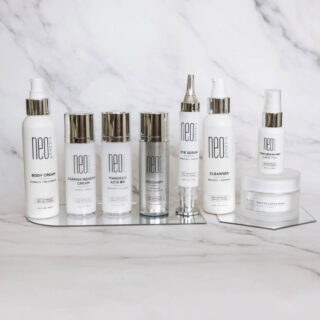Is it time to consider a chemical peel?
Chemical peels are an effective solution to many common skin concerns.
- They “re-boot” the skin and reduce cell turnover time from 1 month to 7-10 days!
- It is fast and dirty but worth it!
- If you want to reduce hyperpigmentation (brown spots) or marks from old breakouts, minimize the appearance of enlarged pores, soften fine lines, and re-energize dull blazay skin, a chemical peel may be worth the downtime.
- Like doing anything well, the key to success lies in preparation and recovery.
Proper preparation:
Preparation takes about 4 weeks and is nonnegotiable. Like exercise, this period of time is for “cell training” through the action of mitosis. Healthy-fit cells accustom to activity respond better under chemically induced pressure. A fit immune system ensures efficient repair and less downtime. No, you cannot use your drug store cleanser after the peel so be prepared to invest in one as part of your prep. Preparatory products include a pH-balanced cleanser (that won’t tingle or burn compromised skin), a lightening product to suppress melanin activity (brown spots), retinal to stimulate cell renewal (regular mitosis) in the epidermis, and a mineral SPF to protect the skin from indoor and outdoor light waves.
Clients who ignore the necessity and safety of proper aftercare generally run into unnecessary inflammation and delayed healing after the peel application. DO NOT aggressively wash your face or play with your flaky skin. I know it is tempting, but step away from the mirror. Unnecessary “assistance” can create unintentional tears exposing new-raw skin before it is ready. You got a peel to get rid of the uglies so why create new problems?
Avoid over-moisturizing, as too much moisturizer will impede the flow of the peel. You requested a chemical peel service so anticipate dry-tight skin and “unsightly” peeling for a few days, followed by dryness and flaking for a few more days. It’s a process. Trying to compensate for the loss of moisture, while it feels good, is disruptive. Take a deep breath and remind yourself, “It is temporary.”
Peeling is not for everyone and lifestyle is usually the biggest deterrent. To work around this hurdle, I generally recommend professional clients come in for their peel on Wednesdays. This way they can go to work Thursday and then take a 3 or 4-day weekend. For someone with healthy skin, I generally recommend peeling 1-2 times a year to reboot the skin. Otherwise, to treat stubborn hyperpigmentation a series of 4-6 is generally recommended, spaced 4 weeks apart. I do not recommend peeling during the summer months and recommend treatments between late October through the end of March.
SkinNERD Bonus:
Chemical peeling is derived from the principals of wound healing. Large wounds heal more quickly than small ones. Have you ever noticed how long your body takes to repair a paper cut? This is due to the fact that the immune response to a paper cut is much smaller than a larger event. The application of a chemical peel is perceived by the body as a large event. This stimulates a greater immune healing response in the tissue. The magnified reaction results in new collagen, healthier connective tissue, firmer pores, reduction in fine lines, and leaves your complexion looking like your 8-year-old dewy naïve self.

 Loading...
Loading...









































Leave a Reply